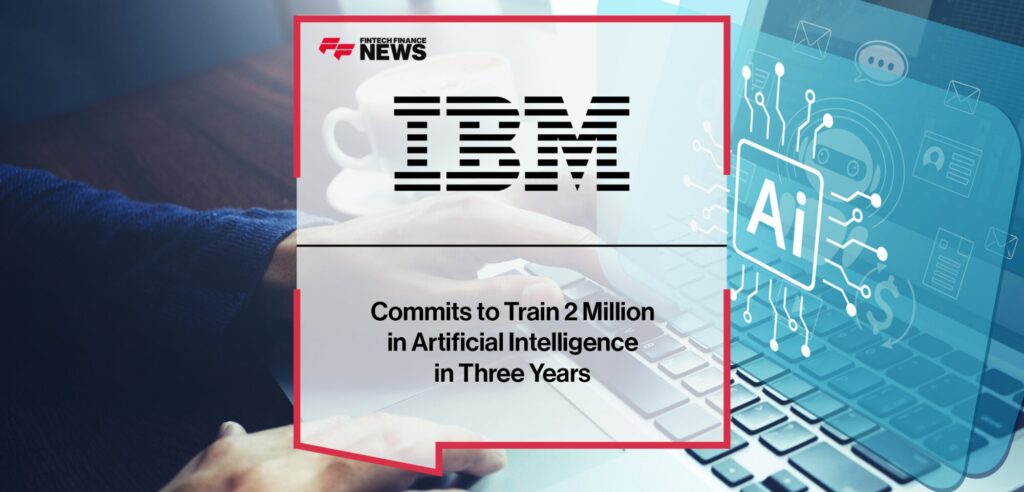Meta, IBM Create Industrywide AI Alliance to Share Technology

I am a law graduate from NLU Lucknow. I have a flair for creative writing and hence in my free time work as a freelance content writer.

I am a law graduate from NLU Lucknow. I have a flair for creative writing and hence in my free time work as a freelance content writer.
IBM today declared an initiative to teach two million students in artificial intelligence by the end of the year 2026, having a concentration on neglected areas, to help reduce the worldwide artificial intelligence (AI) capabilities imbalance. To accomplish this objective on a worldwide basis, IBM is offering new generative AI courses via IBM SkillsBuild, extending AI education partnerships with institutions across the world, and working with collaborators to provide AI training to adults worldwide. This will build upon IBM’s current initiatives and platforms for career development to provide improved availability for technical positions and in-demand AI education.

The latest global research by the IBM Institute of Business Value found that CEOs believe that the implementation of artificial intelligence and automation will necessitate the reskilling of forty percent of their employees throughout the next three years, primarily those working in entry-level roles. This serves as another evidence that generative AI is generating a need for new positions and expertise.
“AI skills will be essential to tomorrow’s workforce,” said Justina Nixon-Saintil, IBM Vice President & Chief Impact Officer. “That’s why we are investing in AI training, with a commitment to reach two million learners in three years, and expanding IBM SkillsBuild to collaborate with universities and nonprofits on new generative AI education for learners all over the world.”
finance.yahoo.com
IBM is working with institutions all around the world to develop their AI capabilities by utilizing IBM’s network of professionals. University professors will have a chance to attend IBM-led training, which includes certifications after completion of immersive skilling experiences and lectures. Additionally, IBM will offer course materials, including self-guided artificial intelligence (AI) learning paths, for instructors to utilize in the classroom. IBM will provide students with adaptable and flexible resources, including free online courses in generative AI as well as Red Hat open-source tools, along with academic instruction from academics.
Learners worldwide may have access to AI education through IBM SkillsBuild, which IBM specialists established to deliver the most recent cutting-edge technological breakthroughs.
Also Read: Google Tweaks Ad Auctions to Hit Revenue Targets, Executive Says
IBM SkillsBuild already provides free training in chatbots, the basics of AI, and important subjects like AI ethics. Coursework and improved features are included in the latest generative AI plan.
Along with workshops, expert interactions with IBM coaches along mentors, learning through projects, availability of IBM software, specialized assistance from partners during the learning procedure, and connections to employment prospects, the improved partner edition of IBM SkillsBuild may also contain these features.

I am a student pursuing my bachelor’s in information technology. I have a interest in writing so, I am working a freelance content writer because I enjoy writing. I also write poetries. I believe in the quote by anne frank “paper has more patience than person
In its newest move to boost its cloud and machine learning abilities, IBM announced on Monday that it will offer Vista Equity Partners a total of 4.6 billion USD in cash to purchase the technology Apptio which is a spend-management platform.
The price of IBM stocks fell somewhat in early trading. IBM stated that it will use cash on hand to fund the purchase and anticipates that it will conclude in the second half of 2023.

The agreement is made at a time when businesses are reducing their technology spending due to adverse macroeconomic circumstances. IBM recorded an earnings rise of just under one percent year over year in the March quarter while cutting around 3,900 positions in the early part of the year.
Also Read: Japan’s Suzuki to Make ‘flying cars’ with SkyDrive
The tech behemoth said that the purchase of Apptio, a software-as-a-service (SaaS) company with more than 1,500 clients and alliances with cloud providers including Salesforce as well as Amazon.com’s AWS (Amazon Web Services), will boost IBM’s Red Hat work, Artificial Intelligence portfolio, along with consulting division.
Since its establishment in 2007, Apptio has offered online management services for IT budgeting, forecasting, including analysis. According to the business’s website, over 90 percent of Fortune 100 organizations utilize its products.
“Going forward, we are opportunistic (on M&A) and looking for opportunities in the software and consulting space,” Senior Vice President Rob Thomas told Reuters in an interview.
Source: reuters.com
Century-old IBM is changing its direction to concentrate on more recent artificial intelligence and services offered via the cloud.
It made its largest purchase to date in 2019 when it paid roughly thirty-four billion dollars for the software supplier Red Hat, and two years later it rotated out its IT facilities and information center firm Kyndryl Holdings. The business completed the sale of a few of its pharmaceutical analysis and information assets last year.
Also Read: Nasdaq to sell debt worth $5 bln to fund Adenza deal
Arvind Krishna, the CEO of IBM since 2020, has kept the 112-year-old business in flux. Even though they would probably be less than the thirty-four billion-dollar Red Hat purchase, he stated a few weeks ago that IBM is still intent on mergers.
According to financial analysts at UBS, Apptio’s sales totaled approximately 233 million USD in 2018 and are projected to increase by 11–13 percent compounding yearly until the fiscal year 2022.
Almost 3 years following the software business’s IPO, the private equity company, Vista Equity Partners acquired Apptio in a two-billion-dollar deal.

I am a student pursuing my bachelor’s in information technology. I have a interest in writing so, I am working a freelance content writer because I enjoy writing. I also write poetries. I believe in the quote by anne frank “paper has more patience than person
Due to ChatGPT’s growth, artificial intelligence is currently the hottest subject in technology. The Microsoft-powered OpenAI chatbot’s use of AI to respond to queries, generate articles, and even present legal arguments has astounded and amazed users as well as big companies like IBM.

Due to its abilities, people are now more concerned than ever about how, when, and whether artificial intelligence will affect their jobs and career. While worries about AI-based technology replacing workers have grown, professionals say it’s not as simple as it seems.
The answer to the question that if AI going to replace certain jobs is certainly a “yes”.
Also Read: Meta lays off tech teams, battering employee morale
According to Steven Miller, information systems retired professor, at Singapore Management University, improvements in artificial intelligence imply that machines can accomplish more and more, which will undoubtedly have an influence on jobs.
“As physical machines, software systems, and combinations of hardware and software get more capable as a result of AI-enablement, it is increasingly possible as well as economically viable to replace a greater share of the portions of the human work of today with machines,” he told CNBC Make It.
Source: cnbc.com
Certain positions, as stated by Steven Miller, are more prone to this compared to others, such as those that require a lot of repeated phrases or that are reliant on specific rules or regulations that define how a thing is supposed to be done.
On the other hand, since they vary so frequently, it is more challenging for technology to replace tasks that need adaptability and flexibility.
Amidst these discussions of the impact of artificial intelligence on the job cuts, IBM has created an uproar in the industry by saying that it would replace about 7800 jobs with AI in the coming years.
Arvind Krishna, CEO of International Business Machines Corporation, claimed that the company expects to halt hiring since 7,800 job positions may be replaced by artificial intelligence (AI) in the years to come.
According to Krishna, recruitment in back-office areas like human resources (HR) will stop or slow down. He also predicted that in the next five years, artificial intelligence (AI) and automation could take over 30 percent of positions that don’t need customer interaction.
Also Read: SAP reports revenue growth in Q1
His remarks come at a moment in which AI has captured the attention of people all across the world with the November 2016 debut of ChatGPT, a popular chatbot developed by OpenAI with funding from Microsoft Corp.
The PC manufacturer told the publication that part of the decrease might involve not filling positions left vacant by attrition.
IBM did not quickly reply to a Reuters request for comment.

I am a student pursuing my bachelor’s in information technology. I have a interest in writing so, I am working a freelance content writer because I enjoy writing. I also write poetries. I believe in the quote by anne frank “paper has more patience than person
Cognos is an IBM business intelligence performance management application that enables technical and non-technical staff in any firm to analyze, extract, and generate interactive dashboards that help the company make important choices. The Cognos tool combines a number of products to allow for contact with a variety of third parties. SAPs, relational databases, and other systems are examples. Cognos is a business intelligence-gathering platform that offers a scalable and self-service analytical solution for company purposes. Because of its highly dynamic nature, it’s an excellent tool for building user-friendly dashboards and reports for any business.
About The Company
Cognos began as a consultancy firm in 1969, founded by Alan Rushforth and Peter Glenister, and eventually expanded into software sales. Cognos was acquired by IBM on January 31, 2008, and the software suite’s history was preserved. It originated as a consultancy firm for the Canadian government, and its first software product, QUIZ, was released in 1979. Cognos switched its concentration from consulting to software sales during the Canadian recession of the 1980s. In 1982, it changed its name to Cognos from Quasar Systems Limited. The word “cognos” is derived from the Latin word “cognosco,” which means “knowledge gained by personal experience.”
It’s a sophisticated business intelligence tool that can be used for data mining, data analysis, event monitoring, and metric visualization. It provides a powerful analytics medium for any firm to foresee market trends and take relevant steps ahead of time, allowing them to stay ahead of the competition. It’s a business intelligence application that lets you create interactive dashboards so you can make better business decisions by anticipating market developments. Almost every organization now employs Cognos for their analytical work, as making vital business decisions at the appropriate time is critical to surviving in today’s competitive market.

Cognos has made working for businesses and organizations a lot easier, and here are some of the ways it does so.
Growth
With an estimated 8% wallet share in the BI and analytics software industry, it is one of the top three players. IBM Cognos Analytics continues to grow at a rapid pace, setting new standards for its competitors. Fortune 100 corporations prefer IBM Cognos, and it is used by some of the world’s most powerful organizations.
IBM Cognos has approximately 31400 clients in all major US regions, and BARC has dubbed it a market leader in integrated planning and analytics portfolios.
IBM Cognos provides significant capabilities for a variety of BI applications, including web-based OLAP analysis, structured reporting, ad-hoc reporting, and dashboards. IBM Cognos manages everything from data modeling and integration to exploration and visualization as an all-in-one platform. It’s an excellent solution for managing massive data volumes and supporting the needs of multiple users at the same time.
Rob Ashe- Ceo
Bridge Growth Partners’ Rob Ashe is an Executive Partner. He was the company’s previous President and Chief Executive Officer after joining in 1984. He was named President in 2002 and CEO in 2004, and he held both positions until IBM bought the company for $4.9 billion in 2007. After the acquisition, he worked at IBM as the General Manager of Business Analytics until 2012.
Mr. Ashe held many top executive positions at Cognos before becoming President and Chief Executive Officer, including Senior Vice President (“SVP”) of Application Development Tools, SVP of Products, SVP of Worldwide Customer Services, and Chief Corporate Officer, and Chief Financial Officer. He has served on Bridge Growth Partners LLC’s Technology Advisory Board. He has a Bachelor of Commerce in Accounting and an Honorary Doctorate from the University of Ottawa. Rob is a business visionary, a successful corporate leader, a community-minded influencer, and a proponent of higher education’s value and growth.

I am a second-year student pursuing Liberal Arts from Nmims. I am a painter, I love reading and have a great interest in cooking. I am also a trained kickboxer. I’ve always had a passion for writing and hence in my free time, I work as a freelance writer.
Every decade checks the boundaries of Moore’s Law, and this decade is no exception. The complexities of multi-patterning techniques built on previous technology nodes can now be implemented with the finer resolution that EUV offers, thanks to the advent of Extreme Ultra-Violet (EUV) technology. This, along with other more technological advancements, could result in a reduction in transistor size, paving the way for the future of semiconductors. To that end, IBM announced today that it has developed the world’s first 2-nanometer node chip.
To be clear, though the process node is referred to as ‘2 nanometers,’ nothing about the transistor measurements resembles a conventional expectation of what 2nm would be. Previously, dimension was an analogous metric for 2D feature size on the chip, such as 90nm, 65nm, and 40nm. However, with the introduction of 3D transistor designs such as FinFETs and others, the process node name is now an interpretation of an ‘equivalent 2D transistor’ design.

Some of the features on this chip, such as transistor fin leakage safety layers, are likely to be in the low single digits in real nanometers, however, it’s crucial to remember the disconnect in how to process nodes are actually called. The debate often pivots to transistor density as a more precise measure, which IBM is sharing with us.
According to a recent announcement, IBM’s 2nm development would boost efficiency by 45 percent at the same capacity, or 75 percent energy at the same performance, as compared to current 7nm processors. IBM is quick to point out that it was the first academic organization to demonstrate 7nm in 2015 and 5nm in 2017, the latter of which upgraded from FinFETs to nanosheet technologies that allow for greater customization of individual transistors voltage characteristics.
According to IBM, the device will fit ’50 billion transistors on a chip the size of a fingernail.’ We contacted IBM to get feedback on the scale of a fingernail since we were coming up with numbers ranging from 50 square millimeters to 250 square millimeters internally. According to IBM’s press ties, a fingernail, in this case, is 150 square millimeters. This equates to 333 million transistors per square millimeter (MTr/mm2) for IBM.
Different foundries have different official names and densities. It’s worth noting that these densities are often classified as peak densities, for transistor libraries where die area is the primary concern rather than frequency scaling – the fastest sections of a processor are often half as small as these numbers due to power and thermal considerations.
Although IBM has not expressly announced the transition to Gate-All-Around / nanosheet transistors, photographs reveal that this new 2nm processor is using a three-stack GAA architecture. GAA will be introduced by Samsung at 3nm, while TSMC will wait until 2nm. Intel, on the other hand, we believe would implement some kind of GAA on its 5nm technology.
IBM’s 3-stack GAA has a cell height of 75 nm, a cell width of 40 nm, and discrete nanosheets that are 5 nm tall and 5 nm apart. The poly pitch of the gate is 44nm, and the gate length is 12nm.
According to IBM, its design is the first to use bottom dielectric isolation channels, allowing for the 12 nm gate length, and its inner spacers are a second-generation dry process design that aids in nanosheet production. This is supplemented by the first use of EUV patterning on the FEOL sections of the process, allowing EUV at all stages of design for essential layers.
Users may be perplexed as to why we are hearing that IBM is the first to develop a 2nm chip. IBM is one of the world’s leading research centers on potential semiconductor technologies, and while not having a foundry offering of their own, IBM produces IP for their manufacturing facilities in conjunction with others.
Back in 2014, IBM sold its manufacturing to GlobalFoundries with a 10-year collaboration commitment. IBM also deals with Samsung and recently announced a partnership with Intel. No doubt, the latter two would collaborate with IBM on some level to ensure the feasibility of this new invention in their own supply chain.
The chip was developed and manufactured at IBM’s Albany testing plant, which has a 100,000-square-foot clean space. The aim of this facility is to leverage IBM’s extensive patent and licensing portfolio for partner partnerships.